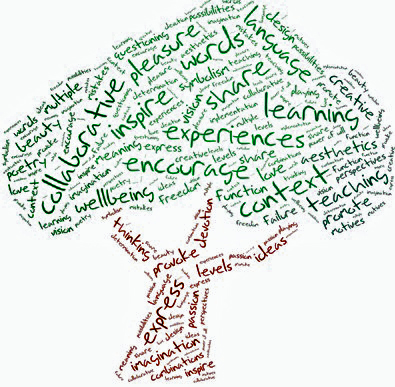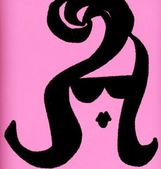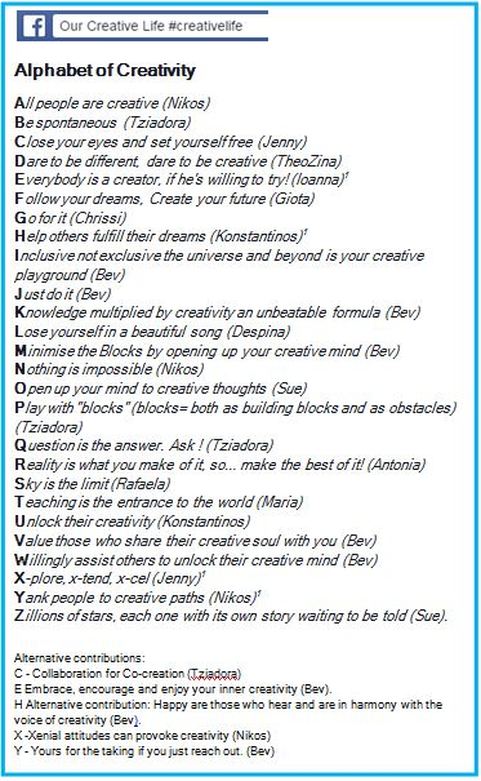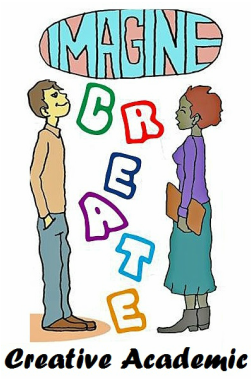'Our Creative Life' New Community Space for Facebook Users
In early January I participated in a discussion with other members of the Creative Academic team to identify ways in which we might get involved with World Creativity and Innovation Week (April 15-21)which invites us to try to do something new to encourage people to be creative.
During our discussion we generated lots of ideas and one of them, establishing an on-line community space on facebook, seemed to hold much promise because many people already have an account and spend a lot of time on facebook. Since I suggested the idea we agreed that I should set it up and so a week later 'Our Creative Life facebook group' was born to provide a space for facebook users to share their thoughts and experiences on everyday creativity. 67 seven people were invited and 45 people accepted and now form the community, with 10-15 regular users. Of course we would like more people to join in so consider this an open invitation to join us. This post describes the process we have been through to try to create a sense of community and its based on an article Theodora and I have written for the April issue of Creative Academic Magazine (CAM4).
Making a start
Starting an on-line community is always the hard. You have a group of people coming together who don't know each other and somehow they are expected to reveal their most personal thoughts. We invited members of the group to share some personal stories and experiences in which they felt they had been creative. Paul helped us get started by revealing how he wrote the lyrics of a song, which was co-written with another member of his band. One of the interesting aspects in this story was the fact that Graham came up with an odd line from his personal life, which eventually provoked Paul to write the “Nebulous” song. Of course, there were multiple contributions by and from different members of the band, so the song is a collaborative creative effort. It must also be noted that this song was produced and performed for a charity concert that was organised in order to raise awareness and money for kids with cancer. Consequently, the context itself gave particular and deeper meanings and significance to this song. Although this was a great example of what we were hoping for most participants did not join in so this initial attempt to encourage sharing was limited.
We then posed the question: How would you describe YOUR creativity? And what are the two most important characteristics that you could attribute to YOUR own creativity?
Fortunately, more participants responded to this question through posts and comments. Jenny situated herself in the field of words and learning and stated that creativity is the pleasure she gets by using words and logic to create and express ideas. She even creates most of the learning material she uses for teaching, while the characteristics that she chose to attribute to her creativity are “words/language” and “teaching/learning”, which eventually contribute to her sense of wellbeing.
For Τheozina, creativity is connected with aesthetics and the beauty of the world around us. As she describes, “creativity is an outlet of our brains to feel that we contribute by making something new with the help of our imagination. I think not everybody can be creative, it is a skill...”. This statement produced a fertile dialogue between Τheozina and Nikos about the nature of creativity as well as about Theozina’s belief that “not everybody can be creative”. The main contradictory argument was that even though creativity is related to imagination and all people have imagination, then how is it possible that all people cannot be equally creative?
At the same time, emphasis was laid on the educational systems and the role of parents and teachers in the formation of creative people. Sadly, there was a common agreement that only a few teachers promote and provoke creative thinking and creativity, something which hopefully needs to be multiplied in the future.
Another contribution made by Tziadora refers to symbolism and the multiple levels of meaning as a creative aspect of her everyday life. For example, poetry constitutes the perfect field to do so by using a word with two or more meanings, or building a sentence which may have a double function. Characteristically, Tziadora provided an example which provoked further discussion and eventually led the participants to resurface interesting elements of creativity. Some of them include: “through questioning creativity blasts”, “seeing multiple perspectives and possibilities in things that seem to be already saturated”, “it’s all about playing with combinations, playing with ideas as if they were a lego set or a coloring palette”. Furthermore, a special reference for creative writing was also made by Tziadora, who shared with the rest of the participants three observations that she had made:
Our Creativity Tree
In early January I participated in a discussion with other members of the Creative Academic team to identify ways in which we might get involved with World Creativity and Innovation Week (April 15-21)which invites us to try to do something new to encourage people to be creative.
During our discussion we generated lots of ideas and one of them, establishing an on-line community space on facebook, seemed to hold much promise because many people already have an account and spend a lot of time on facebook. Since I suggested the idea we agreed that I should set it up and so a week later 'Our Creative Life facebook group' was born to provide a space for facebook users to share their thoughts and experiences on everyday creativity. 67 seven people were invited and 45 people accepted and now form the community, with 10-15 regular users. Of course we would like more people to join in so consider this an open invitation to join us. This post describes the process we have been through to try to create a sense of community and its based on an article Theodora and I have written for the April issue of Creative Academic Magazine (CAM4).
Making a start
Starting an on-line community is always the hard. You have a group of people coming together who don't know each other and somehow they are expected to reveal their most personal thoughts. We invited members of the group to share some personal stories and experiences in which they felt they had been creative. Paul helped us get started by revealing how he wrote the lyrics of a song, which was co-written with another member of his band. One of the interesting aspects in this story was the fact that Graham came up with an odd line from his personal life, which eventually provoked Paul to write the “Nebulous” song. Of course, there were multiple contributions by and from different members of the band, so the song is a collaborative creative effort. It must also be noted that this song was produced and performed for a charity concert that was organised in order to raise awareness and money for kids with cancer. Consequently, the context itself gave particular and deeper meanings and significance to this song. Although this was a great example of what we were hoping for most participants did not join in so this initial attempt to encourage sharing was limited.
We then posed the question: How would you describe YOUR creativity? And what are the two most important characteristics that you could attribute to YOUR own creativity?
Fortunately, more participants responded to this question through posts and comments. Jenny situated herself in the field of words and learning and stated that creativity is the pleasure she gets by using words and logic to create and express ideas. She even creates most of the learning material she uses for teaching, while the characteristics that she chose to attribute to her creativity are “words/language” and “teaching/learning”, which eventually contribute to her sense of wellbeing.
For Τheozina, creativity is connected with aesthetics and the beauty of the world around us. As she describes, “creativity is an outlet of our brains to feel that we contribute by making something new with the help of our imagination. I think not everybody can be creative, it is a skill...”. This statement produced a fertile dialogue between Τheozina and Nikos about the nature of creativity as well as about Theozina’s belief that “not everybody can be creative”. The main contradictory argument was that even though creativity is related to imagination and all people have imagination, then how is it possible that all people cannot be equally creative?
At the same time, emphasis was laid on the educational systems and the role of parents and teachers in the formation of creative people. Sadly, there was a common agreement that only a few teachers promote and provoke creative thinking and creativity, something which hopefully needs to be multiplied in the future.
Another contribution made by Tziadora refers to symbolism and the multiple levels of meaning as a creative aspect of her everyday life. For example, poetry constitutes the perfect field to do so by using a word with two or more meanings, or building a sentence which may have a double function. Characteristically, Tziadora provided an example which provoked further discussion and eventually led the participants to resurface interesting elements of creativity. Some of them include: “through questioning creativity blasts”, “seeing multiple perspectives and possibilities in things that seem to be already saturated”, “it’s all about playing with combinations, playing with ideas as if they were a lego set or a coloring palette”. Furthermore, a special reference for creative writing was also made by Tziadora, who shared with the rest of the participants three observations that she had made:
- Most children who engage in creative writing classes tend to write without fear. They laugh a lot and create alternative worlds. However, there are those, especially at the age of 11-12, who tend to be more skeptical or they do not enjoy storytelling and word experiments
- Their texts have a great psychological and social value. These young writers refer to certain aspects of their life, as it has been transformed in recent years. Ideas-patterns which usually surface are: tablets, smartphones, Facebook, star system, video games… In general, aspects of a postmodern lifestyle involving technology
- How children react to me as a teacher depends, to a great extent, on my performance, on my ability to encourage them. When I create a friendly atmosphere or say jokes, children write creatively and have fun. On my bad days, when I cannot be passionate and pleasant, students are negatively affected, even if I have designed one of my best activities. Learners and teachers emotionally evolved do it better.
Our Creativity Tree

Our creativity tree grew up in the “Our Creative Life” online community by utilizing all the thoughts, opinions, views, perspectives and beliefs that were exchanged on creativity. We came up with the idea of the tree of creativity, as we wanted to highlight not only the multiple resources needed to grow one, but also to lay emphasis on the developmental dimension of creativity. Creativity needs to be cultivated, amplified and eventually expressed. Finally, we wanted to show symbolically that creativity is in our nature and therefore all people are creative in their own unique and special way. By pooling our creativity we can achieve something that is greater than the sum of the individual parts.

Our Alphabet of Creativity
Creative Academic is well aware of the value of games in encouraging people to involve themselves in playful activity. The idea of constructing “the Alphabet of Creativity” emerged as a playful way to engage the members of the group in an activity which is designed to encourage imagination and did not demand a great amount of time. Here is the first post which introduced the game.
Hello everyone, Tziadora had a really interesting and playful idea.
How about constructing the Alphabet of Creativity?
In order to so, each person will write something which is related to creativity starting with a letter of the alphabet.
Example:
All people are creative (Nikos)
Be spontaneous (Tziadora)
C......
D....
E....
etc
P.S. In order not to be confused, add your contribution below as a comment.
Creative Academic is well aware of the value of games in encouraging people to involve themselves in playful activity. The idea of constructing “the Alphabet of Creativity” emerged as a playful way to engage the members of the group in an activity which is designed to encourage imagination and did not demand a great amount of time. Here is the first post which introduced the game.
Hello everyone, Tziadora had a really interesting and playful idea.
How about constructing the Alphabet of Creativity?
In order to so, each person will write something which is related to creativity starting with a letter of the alphabet.
Example:
All people are creative (Nikos)
Be spontaneous (Tziadora)
C......
D....
E....
etc
P.S. In order not to be confused, add your contribution below as a comment.

After that post, everyone could participate by adding their own comment. The only thing that the participants were expected to do, was to pick up a letter and unfold a sentence revealing a view, a perspective, or a short quote on creativity. The alphabet was constructed over 25 days even though there was not a deadline for the completion of the game.
The idea of organizing the members’ contributions as an alphabet instead of collecting free, random thoughts on creativity was preferred for two main reasons. First, the alphabet resembles an open invitation which encourages people to participate and contribute, while at the same time the creative process shows similarities to playing a game. Secondly, the activity is based on free expression, with the exception of one provided restriction: the first letter of the phrase that will be written should be a letter of the Alphabet. Consequently, the Alphabet is an activity built in terms of developmental creativity. At this point, it must be noted that the nature of this task is typically linked to creative writing and improvisational theatre.
The gradual construction of the alphabet has the additional advantage of participants being provided with immediate feedback of the work that has been done so far making it easier to reduce repetitions. However, as it can be seen, there were alternative contributions in some letters, as some participants tried to shed light on different aspects of the topic. Perhaps this game can be played many times according to a particular thought about creativity. The final form of our first
Reflections
When we start something new we begin with hope that it will be of value to someone. The way people collaborated in the alphabet project was the way that we hoped people would work together when we set up the facebook group. But it has taken a while to achieve this.
The many different contributions and contributors mean that the alphabet gathers grows in an organic way gathering beliefs, views and perspectives of different members. facebook encourages interpersonal interaction and new relationships to form and flourish in response to posts that are made. The frequency of posts and the comments made, together with 'likes' expressed by participants, all created a sense of energy as the game unfolded. The 'likes' and 'positive comments' also demonstrated that contributions were valued by other members of the community. Furthermore, feedback was not only provided by the participants, but also from the administrators, an action that promoted the continuation of the game. Our hope is that in playing this and other games we can begin to build a sense of community identity and that this will lead to our members feeling that they belong with this group of people who share many of their beliefs.
Anyone with imagination can have a nice idea but to turn that idea into something meaningful requires work, effort and plenty of creativity. The idea was born in a discussion that was aimed at generating ideas. It didn't matter who suggested it as we were all working together to add value to what we were already doing by extending our involvement to another platform for social learning. Setting up a Facebook group is not difficult if you are a regular user. What is difficult it to attract a group of people to use it in such way that everyone benefits and sees value in participating i.e. the hard work of creativity is to turn a group into a community and Facebook page into a social learning space. Looking back we can see that the strategies we employed have all been directed to developing the will in our participants to share their thoughts, feelings and experiences. This is the nature of development in this context and without it there would be no achievement and no article. So we are only at the start and we invite you to participate in our ed-venture to share your thoughts on and experiences of creativity.
NB IF YOU ARE A FACEBOOK USER PLEASE JOIN US IN 'OUR CREATIVE LIFE'
Nikolaos Mouratoglou & Theodora Tziampazi
The idea of organizing the members’ contributions as an alphabet instead of collecting free, random thoughts on creativity was preferred for two main reasons. First, the alphabet resembles an open invitation which encourages people to participate and contribute, while at the same time the creative process shows similarities to playing a game. Secondly, the activity is based on free expression, with the exception of one provided restriction: the first letter of the phrase that will be written should be a letter of the Alphabet. Consequently, the Alphabet is an activity built in terms of developmental creativity. At this point, it must be noted that the nature of this task is typically linked to creative writing and improvisational theatre.
The gradual construction of the alphabet has the additional advantage of participants being provided with immediate feedback of the work that has been done so far making it easier to reduce repetitions. However, as it can be seen, there were alternative contributions in some letters, as some participants tried to shed light on different aspects of the topic. Perhaps this game can be played many times according to a particular thought about creativity. The final form of our first
Reflections
When we start something new we begin with hope that it will be of value to someone. The way people collaborated in the alphabet project was the way that we hoped people would work together when we set up the facebook group. But it has taken a while to achieve this.
The many different contributions and contributors mean that the alphabet gathers grows in an organic way gathering beliefs, views and perspectives of different members. facebook encourages interpersonal interaction and new relationships to form and flourish in response to posts that are made. The frequency of posts and the comments made, together with 'likes' expressed by participants, all created a sense of energy as the game unfolded. The 'likes' and 'positive comments' also demonstrated that contributions were valued by other members of the community. Furthermore, feedback was not only provided by the participants, but also from the administrators, an action that promoted the continuation of the game. Our hope is that in playing this and other games we can begin to build a sense of community identity and that this will lead to our members feeling that they belong with this group of people who share many of their beliefs.
Anyone with imagination can have a nice idea but to turn that idea into something meaningful requires work, effort and plenty of creativity. The idea was born in a discussion that was aimed at generating ideas. It didn't matter who suggested it as we were all working together to add value to what we were already doing by extending our involvement to another platform for social learning. Setting up a Facebook group is not difficult if you are a regular user. What is difficult it to attract a group of people to use it in such way that everyone benefits and sees value in participating i.e. the hard work of creativity is to turn a group into a community and Facebook page into a social learning space. Looking back we can see that the strategies we employed have all been directed to developing the will in our participants to share their thoughts, feelings and experiences. This is the nature of development in this context and without it there would be no achievement and no article. So we are only at the start and we invite you to participate in our ed-venture to share your thoughts on and experiences of creativity.
NB IF YOU ARE A FACEBOOK USER PLEASE JOIN US IN 'OUR CREATIVE LIFE'
Nikolaos Mouratoglou & Theodora Tziampazi

 RSS Feed
RSS Feed
